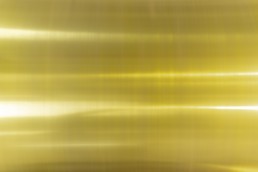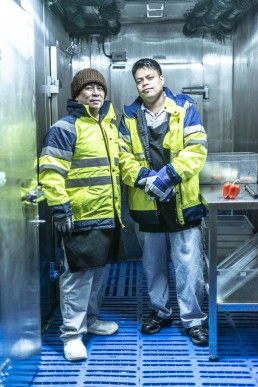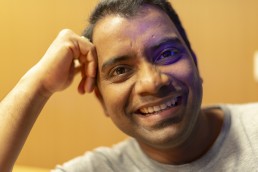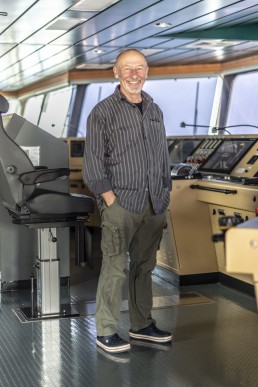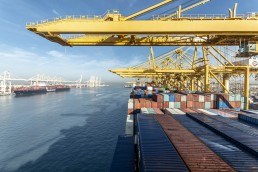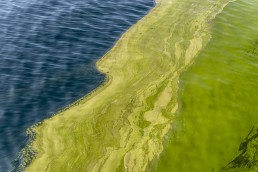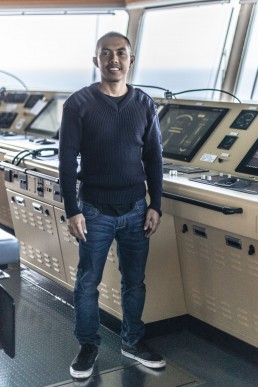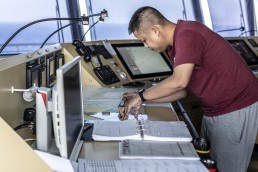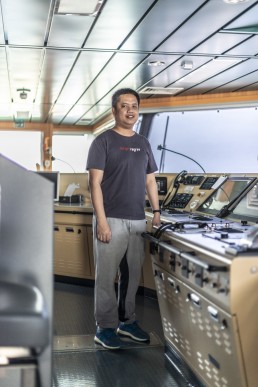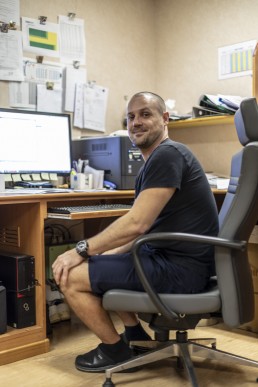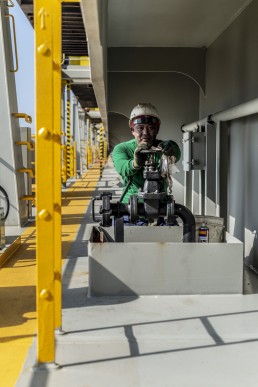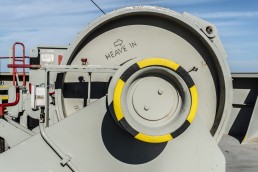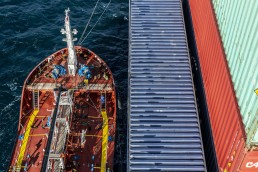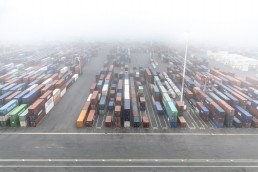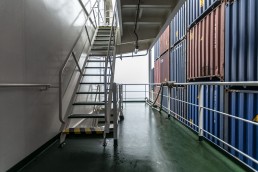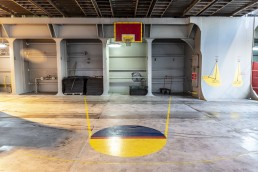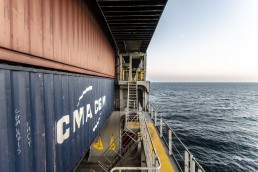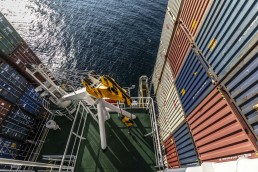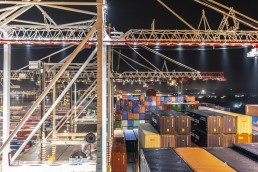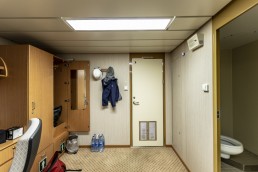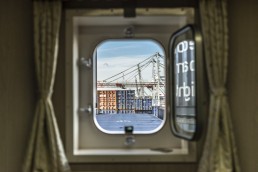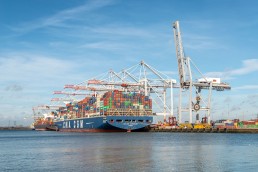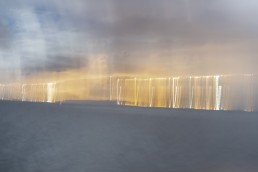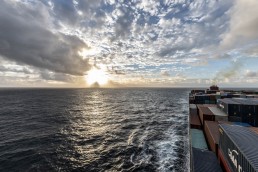Day 1 – Wednesday 14th November
Southampton,
50°54.6 N 50°54.6 W
Starting in June I cycled 2367 miles around the UK to visit 17 Amazon distribution centres. They form a network up and down the country through England, Wales and Scotland, ensuring that whatever I order, wherever I am, arrives hours after I click buy. Carrying only what I needed to survive I pedalled for three months to fulfil my holy pilgrimage of conspicuous consumption and touch the walls of my beloved cathedrals of consumption.
Now – mid November, following on from my bike ride around the UK, I’m sitting here in an overly warm, spacious cabin; a passenger on board the British flagged ship CMA CGM Kerguelen. A four-year-old enterprise class container ship and one of the largest in the world, she transports all imaginable shape and ingredient of my capitalist desire and waste between home and far-off, forgotten shores. I’m here to observe another side of globalisation. Following the Far Asia Route, Kerguelen started in Southampton last week, docked for loading at Rotterdam before returning to Southampton when I boarded. She is destined for China via Suez; Dubai and Malaysia where I disembark.
My reasons for being here are many but I was first inspired several years ago when Mum and I researched travelling to New Zealand on a cargo ship to revisit her childhood experience of traveling to the UK from NZ on a passenger ship in 1946. We made the trip but not by ship due to the prohibitive cost – instead I flew to Russia and travelled overland by train from St Petersburg to Mongolia, China and Hong Kong where we rendezvoused to complete the rest of the journey by affordable air. However, the idea has been floating around my mind ever since. It’s been four years since Mum died and considering all my interwoven ideas related to art, environmental and personal loss, travelling with a low-carbon footprint, considering mass-consumption, plastic pollution and climate change – this seemed like the perfect time to make it a reality.
I found a ship to NZ but there were no places available this year. I was instead offered a place on Kerguelen sailing to Malaysia and then another ship from there that would take me as far as Australia. I turned it down initially thinking that it was way too expensive and that since it wasn’t going to NZ it didn’t fit my narrative but a few days later I suddenly realised by a weird twist of fate that Kerguelen is the same ship I wrote about in my MA thesis last year – a critique of how art effectively communicates environmental issues, in which I tell the story of a plastic bottle accidentally blown into the sea from the Kerguelen, to illustrate the fate of plastic in the marine environment. I paid the deposit for the voyage the same day but had to compromise on cost by opting to fly the second leg from Kuala Lumpa to NZ. And anyway, the prospect of twenty-eight no frill days at sea felt like more than enough.
Caroline drove me to Southampton this morning where we met Maria and took a short walk along the shore of the river Test to get a view of the ship. It’s huge – blue hulled and laden with multicoloured containers. Across the water we had a fantastic view of the dockside, cranes, and non-stop manoeuvring, crashing and banging. An hour later and I check in at the Berth 207 security lodge. A quick goodbye and I find myself struggling to hold my emotions but a minibus takes me, my bike and panniers directly to the ship where a young Filipino man is standing at the bottom of the gangway waiting to help me aboard. There’s no time to dwell. He carries my bike and another young Filipino man is called to take my bags. My bike is stowed in the swimming pool room and I’m shown to my cabin. Then there’s introductions – the Captain, and some of the other twenty-eight Croatian, Filipino, Indian and Chinese officers and crew. A tour of the ship reveals the location of life rafts; muster points; the citadel – a safe room in the lower deck for use in case of a pirate attack containing a few foam mats, a ping pong table and boxes of basic food, water and first aid supplies; the wheelhouse; mess and recreation rooms. I’m left to complete a safety questionnaire, and given a second copy with the answers written on it.
I had arrived with all sorts of goodies – a large wholemeal rye from Reeves in Shaftesbury, Caroline’s homemade banana and honey loaf, a chocolate Lindt bear, a saucisson, Waitrose Brittany butter, olive oil, a box of Sel de Guerrand, cheddar cheese, almond milk, brazil nuts, Dorset Cereals muesli, oat bars, and a bag of real coffee. Alcohol is forbidden by the company – except on their French boats. I’ve been considering whether or not to bring something anyway but ignorant of the security procedures I wimped out and resigned myself to the idea that abstinence will be good for my health. Having discovered a fridge in my cabin, which still has space to spare, I decide to return to Southampton city centre and do some last-minute shopping. However, the reality of what I’m doing starts to dawn and while I can’t have booze that old niggling desire for a cigarette takes me to the tobacco counter in Waitrose. I stock up with enough American Spirit to last a month, curse myself for giving in so easily and then panic buy an extra jumper in M&S and a wide-angle lens in Jessops. I completely forget to buy any food.
Back on board in time for dinner I have the company of two retired Swiss gentlemen. The brothers are on holiday and have been on board around the European leg of Kerguelen’s voyage. They disembark in Le Havre at which point I will be the only passenger and woman on board. We share the end of a bottle of whiskey after dinner and they advise a little alcohol is most definitely required. Fortunately, there’s still time to resolve this in France tomorrow. Wrapped up warm I climb to the wheelhouse deck equipped with my camera, GoPro and microphone. I’m mesmerised by the view for hours – four huge white rail cranes working non-stop along the dock front load and unload our cargo. It’s a hive of activity and the scale of the operation is overwhelming. Powerful flood lights cut shapes in the dark, illuminating the tarmac and the ship; the noise of sirens, beeping, mechanical whirring, the crashing of super heavy metal against metal surround me. Strange eight-wheeled vehicles dance around each other on the tarmac like mythical animals in a surreal ballet, moving thousands of containers to and fro. Those to be loaded are set down by the edge of the dock under the cranes. Operated by a man in a glass cabin suspended high up on each crane arm, they are attached – as it lowers four protruding corners like Alien egg petals close, guiding the platform into position. Once secure it lifts quickly – the cabin, man and container then zip along the length of the arm until in position over the set down point. Each one is secured by four metal joints that slot into the corners of the one below. The operator must align each one perfectly but often miss and have to lift, reposition and ram it down again. This giant game of Tetris is repeated at a remarkable pace – one to two minutes per container depending on the operator’s skill – and continues non-stop until our time of departure at 1:30am. Time is money.
As the ship leaves dock Maria sends me regular screenshots of the Marine Traffic map showing my location. We pass several other enormous freighters moored along the dock; vast expanses of tarmac with rows of new cars and a yacht, all wrapped in polythene; multicoloured containers of varying volume; refrigerated containers; and open-sided, double-height containers holding lorries and oversized wooden crates. Three little tugs named Eston, Harty and Ferriby guide us silently, backwards out of the dock until we reach a wider turning point. The ship comes around and then we’re off, gaining speed, down the estuary; past tiny white sailing boats, buoys, past Hythe, a refinery, crude oil and chemical tankers, the Isle of White and then out into open water.
Day 2 – Thursday 15thNovember
The Channel
49°34 9 N 0°21 0 W
I wake sensing the ship is stationary – we must have docked – but on inspection outside I find there’s no land in sight in any direction. Just the blue sky, bright sunshine and an aluminium sea. We sit stationary for hours. With time to kill I call the ship’s office and am granted permission to ‘go outside’ away from the crew decks. Donning a white hard hat, I set off anticlockwise around the circumference of the ship following a wide yellow line painted on the walkway. To my right railings protect me from the sheer drop down to the sea below. Piles of unused lashing rods are stored in metal crates along the edge of the gangway. To my left grey metal walls support the towers of containers jutting out above my head. Ladders lead up and off to gangways between the blocks of containers. There’s no one around and I have to dare myself onwards overcoming a little but rising fear. I’m acutely aware how easily everything around me could kill me if incorrectly secured.
Towards the back of the ship the engine tower divides two blocks of containers. It rises up above them belching out yellow fumes into the atmosphere. I’m told that the quality significantly diminishes outside of Europe where the emissions turn to thick black smoke. On the bow of the ship the space opens up to a large area containing a crow’s nest and radar; two winches with enormous anchor chains that disappear down their respective tunnels; and thick ropes wound around mechanical wheels. I walk the full length of the left side of the ship – 397.866 meters – around the back where the sound of sea water thrashing out from the propellers is deafening; down into the lower rear deck and then back up along the right side until the crew decks.
In the wheelhouse a phone call comes through to inform us that the pilot will board at 3pm. We were due to dock at Le Havre by 1pm today but in the end are forced to wait for a berth until 7 in the evening. I wanted to go into the city but it’s too late for shopping – I’ll have to wait for the morning. I use the opportunity to film the loading operation again – from the top deck outside the wheelhouse I shoot fixed frame ten and twenty-minute clips recording the activity below and to the sides.
Day 3 – Friday 16thNovember
Le Havre
49°34 2 N 0°19.4 W
After an early breakfast I share a taxi into Le Havre with my fellow passengers who are leaving the ship today. The taxi driver gets me through security with a photocopy of my passport. We say goodbye in the city centre and I venture off in search of wine and French delicacies. I have five hours to kill. One delicious real coffee later, smuggling wine on board becomes the priority and I tour the supermarkets to find the best option. One three-litre box of Cote de Rhone from Carrefour and one three-litre box of Touraine from L’Eclerc. Ca suffit? My new Santander credit card with zero % foreign transaction fees is refused at the till. The pin is apparently locked and can only be unlocked by me at a cashpoint with pin services in Britain. Several phone calls later I get it working and calm down again over a steak tartare, frites, profiteroles and glass of Chablis in the best-looking brasserie I can find. Then a quick trip to Marionnaud to buy perfume on behalf of my new friend, Dennis the messman – apparently named after Dennis the Menace, who wants gifts to take home to his wife in Manilla. Unlike the rest of the crew he never gets to go ashore because he has to be on duty helping chef Saturnino Jr Canceller, aka Bonbon, for each of our three meals a day. I pop a bar of French artisan chocolate orange in the bag as a gift. In the central market I forage for old favourites: fromage de chevre, comte, saucisson sec aux noisettes, biscottes, Bonne Maman apricot jam, pretzels, olives and rye bread. Nobody checks anything on the way back and I climb aboard with all my booze intact.
We depart from a foggy Le Havre – our last dock and opportunity to touch land until Dubai. There are 167,012 ships currently being tracked on the MarineTraffic.com map, which surround UK shores on all sides and makes the Channel look like a busy European motorway of red, orange, blue and green ship-shaped graphics that curve around the tip of Britany and south across the Bay of Biscay, past Spain and Portugal and then into the Mediterranean Sea en route to the Suez Canal and beyond. Leaving the safety and familiarity of shore I feel as though I’m travelling to space. Soon to be distanced and disconnected from my habitual world, I make my last phone calls and say goodbye to friends. My sense of the journey ahead is shaped by a mixture of excitement, loneliness, sadness and fear, but there’s no turning back now – I am committed to this self-imposed time in the prison of my mind and the empty corridors and gangways of the ship.
It’s night and pitch black. I climb up to H deck to see the view but there’s nothing. The wheelhouse is deserted, there are no voices or footsteps in the corridors. The outside lights are off and the boat is moving like a ghost, cutting through the black sea. I have to conquer a tingling fear standing among the dark brutal metal to stay just a little longer and take it in. The ship is so big and the sea so calm that I feel as though I am standing upon a 100m tall towering block rooted to the sea floor. There’s no pitch or roll and the engine hum so faint I can barely hear it over the whirring air conditioning inside or the waves against the hull below. The only point of reference and indicator of our forward motion I have are the faint white crests of the diagonal wash moving past us below.
My cabin window looks out toward a maroon container, the eighth stacked in metal wall 21 across x 9 high. Inside, I have a double bed; a fitted sofa with a coffee table chained to the floor in front of it; a writing desk with built in fridge, drawers and a wardrobe. There’s an en suite bathroom with toilet, sink and shower, complimentary towels and a bar of Lux soap. There’s little entertainment on board – just a small gym, a library containing maritime manuals, an empty swimming pool and a variety of mess rooms and cabins set across eleven decks, all decorated with the same beige colour scheme, copies of the crew list, emergency information and the odd framed A1 poster of a Van Gogh, Manet, Klimt and the like. Analogue clocks hang on the walls of every room and change automatically as we cross time zones.
Meals are taken in the separated crew and officers mess rooms, which adjoin the left and right side of the kitchen. I have been allocated a table to myself in the officers’ mess. Breakfast, lunch and dinner condiments remain set out in front of my place awaiting prompt daily use at 7am, 12pm and 6pm. Each meal consists of a range of soup starters, main course (my vegetarian request has so far consisted of chicken stuffed with garlic, bacon and cheese; red peppers stuffed with beef mince; and a pork stir fry), and desert of either fruit or the cake of the day.
Day 4 – Saturday 17thNovember
Bay of Biscay
49°00 6 N 5°35 1 W
I wake at 9am and have missed breakfast again. This is probably going to be the way of things most days as the evenings seem to evaporate into the early hours as I sit at my desk, writing, editing film footage and photographs. Last night was taken up downloading things to keep me occupied for the days ahead with no WiFi or mobile network connectivity.
The ship is starting to gently roll. After a coffee and a cigarette outside on deck I change into my shorts and t-shirt and descend to B deck to the deserted gym. I’m conscious that a sedentary month at sea with ample food does not bode well. To overcome this and a mild nausea brought on by the lingering smell of diesel fumes in the gym I decide to try out all the apparatus. There’s a bicycle, weights, a dart board and a running machine, which turns out to be the surprise highlight considering my dislike of running. I complete an hour-long session and leave reassured that my fitness level isn’t a complete disaster.
We’re lost in the clouds today – thick fog envelopes the ship, touching the water and masking the horizon. I can barely see 50m ahead. A steel coloured sea delivers rolling swells that approach from the right-hand side, pitching the ship so that the sea completely disappears and tips the cloud into my horizontal plain of view. With every swell the clanging of metal reverberates through the ship. Sticking my head around the side of the deck wall the wind knocks me back and steals my breath, momentarily causing me to gasp for more oxygen. A small bird that I can’t identify flits from container to ship and back with a shrill chirp. The wind whooshes and whistles between the gaps growing ever stronger. From my open cabin window, I can see the towers wobbling and I can hear their contents slamming back and forth within. At lunch the Captain reminds Dennis that everything needs to be secured: “Anything breaks, you pay. Secure everything and check the passenger’s cabin. One glass, Dennis pays”. My apple rolls across the table.
As the night draws in the swell increases in intensity. No one seems bothered at dinner but standing outside for five minutes watching the sea rising and falling leaves me fearing the worst. It’s the angle of the containers against the sea. I find myself evaluating whether it’s best to be inside or outside; in the lower or upper decks? If the ship were to capsize how long would we have? I retreat inside to my cabin where the effects seem less exaggerated and the sounds of snapping metal muffled once the window is shut tight. Would it keep the water out? My telephone rings – Peter the second officer would like me to join the crew in their recreation room. It’s Ferdinand’s 52ndbirthday party. This is a secret party and I mustn’t tell the officers or the Captain. Alcohol is not allowed on board, even for passengers but clearly everyone, including me, has their stash. There’s whisky, beer, snacks, very bad multilingual karaoke and reassurance from second officer Peter who, holding a whiskey, slurs: “The sea is very big, many ships sink here, better to be with us”. He says he’ll change course later so we don’t die. I wonder how well he can navigate Biscay on whiskey.
I’m served beer from a keg that slides across the table on every roll. Everyone takes their turn to sing and it gets progressively more raucous as the whiskey levels go down. Peter becomes more and more lecherous, proud to have been the one to invite me, reminding me that he was the bravest to phone, thanking me for coming, apologising for disturbing my evening, asking if he can touch me. Bloke who’s name I can’t remember shows me photographs of his wife and five children and a picture of him in Southampton at a Rolling Stones concert. Why am I not married? I ask him why he’s married and he tells me he needs someone at home to look after his land. Like a child, Peter attempts to attract my attention by calling my name over and over again until I acknowledge him. It’s my turn to sing. I don’t know the tune but miraculously the microphone seems to make my invented harmonies sound OK. Again, why am I not married? Don’t I like boys? As the men start dancing the singing gets louder and t-shirts come off. I take this as my queue to say goodnight. Dijesh tries to kiss my cheek while taking a selfie – I move away and he apologises. Peter insists on accompanying me despite my declining his offer. I avoid sharing a lift with him, instead taking the stairs but he follows me to my cabin where I finally get rid of him at the door with a polite but firm “No”.
Day 5 – Sunday 19thNovember
North Atlantic
43°40 1 N 9°07 8 W
It turns out that there is WiFi on board and yesterday the Captain set up my account. I was surprised to find that I will be charged for this considering the cost of my passage. I logged on last night to search for the answer to the question: ‘can a container ship capsize?’. The connection is very slow but did return results to confirm, yes, they can, providing several articles and photographs that left me cold. Lying in bed half asleep, the motion of the ship rolling from side to side seems so extreme that at one point I am convinced that we have passed the tipping point and are irretrievably on our side turning 180°upside down. I hold my breath for what seems like an eternity as we pitch. Opening my eyes to reorient I find that I am in fact still in bed and not pressed to the ceiling. We tip back and I try to sleep again, praying for calmer water.
On reflection this morning it was clearly nowhere near as bad as I had imagined – my collection of fruit is still where I placed it on my desk. We are near the northern coast of Spain – the sea is a bit calmer, the air warmer and there’s a just enough of a mobile signal to message Caroline and Laurence with my hair-raising updates. Google maps tells me that I’m in Santiago de Compostella. The sky has cleared a little too – there are breaks in the cloud revealing a pale blue sky above and sitting outside with a coffee I am greeted by a robin who lands briefly on the side of one of the containers before flitting off again to another part of the ship.
Lunch comes too soon and I’m presented with chicken soup, steak, chips and a salad. Most of the afternoon is spent writing. I film the wobbling containers from my cabin window and review the footage from last night of my wine glass magically moving across the desk. As cabin fever sets in I resolve to revisit the gym and run for half an hour. Yesterday I completed programme number one, so today is number two. I’m genuinely surprised to find I can run. Both programmes are a bit too easy so I up the ante with a steeper incline and throw in some sprints. Strange to be running on a rolling boat – I’m propelled forwards and backwards but avoid any embarrassment. In my cartoon head I’m flying off the back of the treadmill and unceremoniously splatting the wall. It feels so good to be moving my body and raising my heart rate. Today Vasilije, the second engineer, joins me in the gym. He’s curious to know how I’m finding the ship’s motion; his first day at sea was spent throwing up. For me, so far so good. I did take a precautionary Cyclazine last night but other than that haven’t felt the need for any medication. Vasilije tells me that the sea last night was moderate and that the ship can withstand far worse conditions. I’m sure, but nevertheless it was unnerving enough and I hope I don’t have to experience anything close to the ship’s limits.
Chicken soup, smoked salmon, gherkins and pizza are tonight’s menu. Each meal time feels a little excruciating being sat separated from everyone else in the room. I eat in silence other than the initial greetings on entering the mess. The dusk, visible from a single window, falls through deepening pinks and oranges. Condiments are now secured in a plastic crate in the centre of the table. After everyone has retired to their recreation rooms Dennis tells me about a bird trapped on B deck last week – it eventually found freedom – and about seas big enough to slide the heavy chairs, tables and contents of the galley from side to side. He likes being at sea, finding moderate rolling a relaxing environment to work in, but he misses his wife and daughter. He’s been away from home for six months and is counting down the days to Malaysia when he signs off for two months at home.
Day 6 – Monday 19thNovember
North Atlantic / Strait of Gibraltar
36°26 3 N 9°17 8 W
A knock at my door wakes me. It’s 8:45am. Dennis is standing in the corridor holding a coffee maker and a packet of paper filters. He also has more real coffee downstairs in case my supply runs out. I plug it in on the floor next to the bed and while it percolates, I wonder why everyone is drinking Nescafe. On my starboard deck a chair, table and sun lounger provide ample comfort to enjoy a mugful in the warm morning air. Heaven!
Venturing upstairs to the wheelhouse I take position on the starboard side lookout chair and scan the horizon. It’s super bright outside and the sunshades are down over the front windows to reduce the glare. It’s a clear day and I can see for miles. Vast swells approach, pass underneath and ever onwards behind us. From this vantage the ship is solid in the water, even at our maximum pitch. I’ve become more accustomed to and accepting of our angles and find the now seemingly gentle rise, fall and roll of the bow mesmerising. The towers of containers are mostly static as if part of the ship’s main structure. We are carrying all sorts of contents including food, materials, cars and a yacht in the hull.
A twenty-two-year-old Chinese cadet from Anhui called Qianxiang (he invites me to call him Cheng) shows me the different controls and screens. Kerguelen is travelling southeast at a speed of 20 knots, drifting slightly at 1.5°at 1.2 knots. Her eleven-cylinder engine has three turbo chargers and three air coolers. It’s currently running at 74.2rpm, generating 41890kw of energy and is consuming 131 litres of fuel per minute! We’re inching our way around the southern coast of Portugal, destined for the Spanish port of Algeciras. Our schedule had been planned for anchoring and bunkering off the coast of Gibraltar but the Captain tells me the sea is too deep at 80 metres to drop anchor there. We should make land later tonight. No fish in sight.
Lunch today is beef soup, followed by chicken in a tomato and pepper sauce served with boiled potatoes and vegetables. Dennis asks for a convenient a time to clean my cabin and change my bedding – I suggest he comes for coffee and a slice of cake on Wednesday. We talk about his home in the Philippines, and his pet tarantula called Spidey that escaped and hasn’t been seen since. I’m invited to Manilla – Dennis lives near to the airport with his wife and ten-year-old daughter – he promises to collect me in person when I arrive and will show me the places to go and those to stay clear of. He is so sweet – engaging, conscientious, respectful and not at all inappropriate in making great efforts to ensure that everything is perfect for the passenger he had prayed for – young and light-hearted rather than the more frequent older variety – and I have arrived. It’s a miracle!
The afternoon light over the water is magical. We are headed east towards the Strait of Gibraltar – a yellow sun tints the clouds and the sea ahead of us and rain drags a heavy cloud down towards the water. Falling on a concentrated patch and breaking the surface tension, it turns the water from steel blue to a white haze. After dinner (beef soup again, followed by pork escalope, followed by crème brulee), darkness descends and the lights of Tangier and Tarifa become visible. My iPhone starts buzzing as a raft of messages stream in on an intermittent signal. Flashes from a distant storm light up the sky somewhere to the south as we turn north towards Algaciras – and a text message from O2 arrives welcoming me to Morocco and informing me that I have almost reached my 50MB/£48 roaming data limit. Bollocks.
Day 7 – Tuesday 20th November
Bay of Gibraltar / Algeciras
36°09 3 N 5°24 4 W
Happy birthday Mum.
We’re anchored in the Bay of Gibraltar, midway between Gibraltar and Algeciras, taking on bunker fuel from a comparatively tiny ship. From the wheelhouse deck I can stand directly above and watch the proceedings. She is tethered along our port side, the two hulls separated by a large black inflatable buoy. A thick hose pipe connected to Kerguelen is delivering the 1500 tonnes of fuel required to take this ship to China. The horseshoe bay is lined with refineries and docks. The Rock of Gibraltar marks the end of the promontory – I can remember visiting as a child – crossing La Linea de la Conception, walking along Main Street and up to the top of the rock to see the monkeys. I was wearing a white t-shirt, white shorts and a white towelling sun visor with a transparent blue plastic peak.
Safely connected to the Spanish mobile network I’m able to catch up with emails and online updates. Priority number one is to download Bjork; number two go to the gym – today is programme 3 on the running machine but it’s still too easy so trying to remember the core strengthening routines Row taught me earlier in the year – press ups, crunches, burpees (hate them), planks and some weights. The rest of the day is spent fiddling about online and blissfully listening to Radio 4 – Tracey Thorn is interviewed by Lauren Lavern on Dessert Island Disks and a super interesting episode of Costing the Earth discusses whether art can effectively help people understand environmental issues. David Buckland talks about his project Cape Farewell and I remember a conversation with him when he suggested I find my own way to the Arctic rather than join the residency last year. Why didn’t the BBC interview me? In the news I read about the Extinction Rebellion protests in London; a dead whale in Indonesia containing plastic in its stomach; how tourists are loving nature to death; and a piece by Nicholas Serota talking about art and the environment. I avoid politics.
Lunch was bean soup, Asian beef stir fry with rice, followed by melon. Dinner is bean and sausage soup, beef spaghetti, followed by apple strudel. My trousers feel tight. When Dennis was younger, he wanted to join the army. His mother told him not to because he would die. Now, too old and too fat (his words), he wants to start his own catering business in Manilla. He knows how to cook for people from all over the world – before working in cargo he worked on cruise liners and he knows that good food is the one thing he can make to make everyone else happy. He just needs to save enough money to find a suitable premises in a good location. With luck, on his next job he’ll be promoted and employed as the chef.
In the empty early evening corridors, I can hear screechingly bad karaoke seeping out of the crew recreation room again. It’s chef Bonbon’s 54th birthday. I’ve opted out this evening preferring a quiet glass of red to end the day but feel a tinge of guilt for not joining the fun, which is made worse by a succession of phone call invitations. I miss Mum and Dad and just not in the mood but there’s no way to explain all that. Outside it’s dark and drizzling. Looking down at the sea I imagine jumping into a black hell, resurfacing, fighting for air, swallowing sea water and scrabbling against the hull to find a way back as it passes, leaving me at best only momentarily conscious and alone. How cold would the water be here? How long would it take to succumb? Would a life ring make any difference? Dennis told me earlier that the secret to survival is floating and not swimming – and that if you enter the water you should always wear socks so not to attract attention from sharks with white feet – but no one would know I was missing until tomorrow and there’s no land for miles. What am I doing here again? My heart sinks.
My ship’s pass arrived outside my cabin door earlier and declares my ‘function’ on board as being a passenger. Being here is a privilege and an indulgence but for me, my function is more ‘artist in residence’. I’m an observer collecting stories to take home and share – a less aggressive approach than harder-line activism. I hope I’m not casting any judgement, rather holding a mirror up to myself and society, and empowering people to think. And how did I get here? Weirdly, it turns out to be very easy – I bought a ticket from a travel agent. A quick search on Google and I came across a company based in London called The Cruise People. We discussed route options and having settled on this ship I was sent their bank details to transfer the deposit and final payment, and a raft of paperwork from the shipping company that I was to complete, sign and return including: an identity form; a statement of responsibility; a medical declaration to be completed and signed by my GP also stressing that there is no doctor on board; a letter of indemnity; and the company terms and conditions. Along with these I also had to provide proof of insurance including all repatriation costs, a copy of my passport and a yellow fever vaccine certificate. A week before the scheduled date of departure, I received an email to say the date had been pushed back ten days. Then a week before the new date I received another email with ticket and instructions to contact the port of Southampton for all further departure details. The port manager confirmed he was expecting me, gave me the address and time to arrive. I showed my passport at the security gate, once on board, and that was it. Nothing was ever scanned, searched or weighed.
Day 8 – Wednesday 21st November
Mediterranean Sea
36°55 0 N 2°03 7 E
I’m up and dressed in good time this morning. Last night, Dennis promised to bring a pot of sugar up to my cabin. He arrives at 9am having finished the breakfast service and hands me a small catering-style steel pot with lid and tea spoon. We talk about human trafficking and he recommends a Korean film called The Flew, in which a group of stow-aways perish inside a container. I offer coffee and cake but he can’t be seen not working. Every so often, he glances down the corridor checking for spies. Apparently, the remaining apple strudel disappeared over night. We are skirting along the coast of Algeria, which must be no more than 25 miles to our starboard side. I’m listening to a podcast series called Containers recommended yesterday by my friend, Ellie. It echoes my experiences so far, bringing to life in words the dockside prehistoric metal dinosaurs I saw in Southampton and Le Havre, and everything I have seen and thought about on board.
Containers / containerisation – the embodiment of Capitalism. Responsible for the economic geography of the modern world, for the growth of cities and ports, the rise in automation and cheaper Asian manufacturing, and the decline of Western portside workers, jobs, industries and communities. Until the 1950s the ship itself was the container, with freight stored inside the hulls and bulkier items placed on deck. In 1956 truck company owner, Malcolm McLean, designed an interlocking container that could be transported by lorry and lifted directly onto a purpose-built ship. In the ‘60s the need to organise and transport military supplies across the Pacific during the Vietnam war accelerated global shipping standardisation and the development of modern trade routes. Five-hundred million tonnes of freight was moved around the ocean in 1950, now up to ten-billion tonnes is transported every year. Coffee, tea, meat, grain, pulses, sugar, salt, tobacco, metals, stone, t-shirts, cotton, flip-flops, furniture, paper, plastic, toys, tennis rackets, cutlery, appliances, electronics, cars, works of art, chemicals, components, soap, clingfilm, cosmetics… Almost everything we buy has travelled for weeks across the seven seas to fulfil our consumer expectations, costing next to nothing, filling supermarket shelves and online stores, arriving instantaneously courtesy of local delivery drivers. Store purchase data is fed through the global supply chain network with sales statistics indicating product popularity and potential corporate profit. Every single time we buy an item, we fuel its demand just a little bit more, creating a need for more resources, more fossil fuel extraction, more mineral and rare-element mining, more agriculture, more chemical processing, more manufacturing, and producing more waste and more pollution.
As distant from our lives as the effects of climate change seem to be, we don’t see or hear about the environmental effect of our consumer economy other than in below-the-fold news articles and scientific papers – 2-3% of greenhouse gasses come from shipping alone. The quality of bunker fuel is different around the world. Third officer, Warren, shows me a bunker fuel-quality map in the wheelhouse – cheaper, high sulphur emitting fuel is banned in some areas like around the UK, but not in others. He tells me that in America ships must now connect to an electricity supply in port but in other parts of the world this isn’t an option so the engines are kept running, contributing to localised atmospheric pollution and causing high cases of asthma, lung and other related health problems. There are emissions from the related transport networks, manufacturing processes, and the growing mountains of objects, materials and packaging we discard to landfill every day. The ecological impacts of our ocean super-highways on marine life include noise pollution, spillage and the dumping of waste, but all this is managed behind the scenes, away from more pressing day to day concerns of the general public – painting a utopian picture that hides reality, absolves us of individual responsibility and encourages our desire and expectation for more stuff, more convenience and more comfortable lifestyles.
My grandfather, Guy Sangwin, spent his life working in the Merchant Navy. Mum used to recall how little time Guy spent at home – she barely knew him. It must have been tough for her mother, Gwladys, emigrating from New Zealand to the UK for a life spent alone keeping the home fires burning, raising Mum and her three siblings. The people who work on Kerguelen are at sea for months and they have all spoken about how they miss their families but there’s an obvious class divide – high-ranking white officers complete three to four month stretches while the lower-ranking mostly Filipino crew can be away from home for ten months at a time. They work together but they eat and socialise in separate mess and recreation rooms, and they reside on separate decks – all ships are built like this, engendering these divisions.
The past couple of weeks have been taken up by dock work. Now we are at sea the backlog of maintenance duties must be completed. Chief Officer, Siniša, has been downstairs in the hull checking pipes for corrosion. In the laundry, he shows me how muddy his overalls are and explains the tunnel system he must crawl through. It’s dark and claustrophobic. He feels his way up, down and around the maze of shafts. He can navigate by the concavity of the hull being either on his left or right side and he knows he’s completed a circuit when his fingers feel the access hatch, but you can get disorientated. There must always be two men working together – both carry torches on their head and breast to light the way and oxygen in case they panic. It’s dirty work and he doesn’t think I can visit this part of the ship – he’ll show me photographs. A short while later he knocks on my cabin door and hands me a pair of thick rubber gloves and some ear plugs: “Now you are ready to visit engineering”.
In the gym, Zoran, Davor and Karlo are sat on the floor around the cycling machine. The side panel is off and they are peering at its circuit board and components. “We are electricians. We go around the ship and fix things. But not this – this is for the rubbish”. There’s a problem with the magnet, which controls the level of resistance, meaning that there’s no resistance at all. They pack up tools and move out to fix a washing machine somewhere upstairs. It’s Underworld’s album Beaucoup Fish and running machine programme 4 for me. Still too easy. More weights, crunches, push-ups, planks and a hill climb on the bike in preparation for tonight’s dessert.
The white buildings of Algerian coastal cities are clearly visible and the calm Mediterranean is a deep Prussian blue in the afternoon light. There are barely any crests and as I stare into the water below, I spot floating sticks, smaller unidentifiable floating debris, something orange, a large white sheet of plastic and dolphins! Gliding just below the surface they jump out of the water and surf along in our wake. It’s just warm enough for a t-shirt in the shade.
As I take my dessert – a large wedge of marble cake – out of the mess for later enjoyment Dennis smiles and says: “I can see you’ve put on five pounds”. Unfortunately, I think Dennis’ wit is more an astute than he intended but not enough to prevent me from also accepting a pot of Nutella with the explanation that he didn’t add much sugar to the cake because “you’ll think it healthier, but you might like it a bit sweeter”. Already full, I can’t resist tucking in, with Nutella and red wine – great combo.
Day 9 – Thursday 22nd November
Mediterranean Sea
37°09 6 N 11°36 9 E
Dwarfed by our mass, tiny Tunisian fishing boats dot the horizon, some, surprisingly close to us, bob up and down all over the place in our wake. On the international ocean road vessels drive on the right. Depending on who is port or starboard determines who is supposed to alter course and get out of the way but the system doesn’t always work, so the crew maintain a twenty-four-hour watch on the bridge. I’m waiting in anticipation this morning for the scheduled general emergency drill. Seven short and one long blast of the ship’s siren indicates a general emergency. Repeated short and long blasts indicate abandon ship. In any case I am to muster on the bridge ‘under Master’s orders’. In the case of abandon ship, I must take my orange immersion suit, stored in a cupboard under my wardrobe. Can I try it on? 😀
I’ve decided to record audio today and have wired my iPhone up to a lavaliere lapel mic. At 10:30am precisely the alarm sounds followed by an intercom announcement from the Captain confirming that: “This is a drill”. I climb up three decks to the wheelhouse and spend an hour drinking Nescafe (he doesn’t know how to operate the real coffee maker) and chatting with the him about Croatia, seafood, sailing, his wife and sons – one is an artist and also smokes roll-ups. The rest of the officers and crew roleplay a medical emergency downstairs on B deck. They must experience being inside the small interior of the life raft, test the emergency telephone system and watch launch demonstrations. There will be a pirate attack drill after Suez.
Recording yourself talking is interesting – I have discovered that I say OK a lot. I need to review my conversation skills. At lunch I change tactic to smiling, nodding, more questions and the odd “mmm”. Dennis is recounting how he first asked his now wife out on a date. He is very shy, especially around girls. They met at school when he was 24. He took her a flower picked from his garden and cheap chocolates saying “this is all I can afford now but I will improve”. They were married three years later. He loves romantic music. Apparently, power ballads are very popular in the Philippines. I concur; the karaoke definitely confirmed this. I’m dying in romance.
Day 10 – Friday 23rd November
Mediterranean Sea
34°42 31 N 20°38 6 E
Dennis arrives in the morning to change my bed sheets. It’s a tricky exercise that requires leaping over the mattress to fit the sheet. I demonstrate my ghoulish shake-duvet-cover-over-the-head technique. At 1pm the clocks go forward an hour.
I’ve requested a visit to engineering. Vasilije and cadet Wu meet me at 4pm to show me around and we descend into the bowels of the ship, past the air conditioning and refrigeration units, to a sickly deep-latex-yellow coloured corridor that runs all the way from the front to the back. I’ve brought my hard hat and rubber gloves but apparently, they are not required. Wu carries them for me. It can reach up to fifty degrees centigrade down here. The temperature rises as we walk and touching the wall, I can feel the heat of the sun against the hull. I can hear the sea crashing against us and the whirr of machinery. A little way along the corridor, we pass the pilot hatch with the words inscribed ‘to be kept closed at sea’. When boarding the pilot pulls alongside Kerguelen and must climb across from the bow, through another hatch below, up the ladder and emerging here.
Savo, the chief engineer, is sitting at his desk in the centre of the engine control room. He trained as a marine engineer but tells me that you can only learn on the job. Every ship is different and there are always new situations to overcome, things to maintain and fix. The walls and panels are covered floor to ceiling with buttons, switches and lights. As we enter the main engine room the temperature rises and I can feel beads of sweat rolling down my skin. The sound is deafening. I fit my yellow 3M earplugs and follow Vasilje on a frustratingly quick tour. It’s impossible to hear any of his explanations and I struggle to frame any decent shots as he strides ahead. The engine is massive and fills a cavernous space. Huge pipes lead off the eleven cylinders. At the far end, spare parts, oversized spanners and tools, are set out ready for use. Two giant replacement pistons wrapped in foam hang from custom wall fittings. Gangways and ladders lead us over three floors around the engine past the air coolers, turbo chargers, inlets, exchanges, a workshop, and the steering mechanism – a huge brass cylinder aligned with an engraved scale indicating our direction in degrees. We walk to the very back of the ship, down a narrow gangway set next to, and then over and along, an exposed brass shaft rotating at high speed, turning the propeller.
Day 11 – Saturday 24th November
Mediterranean Sea
32°28 2 N 29°03 8 E
I couldn’t sleep last night and I can’t wake up this morning – it’s 11:30 before I pull the blinds. I skip lunch for a leisurely coffee on deck and spend the afternoon writing and filming myself talking about art. It’s a four-minute piece for another residency application.
I think this is the weirdest place I’ve ever been. Getting to know the men and feeling comfortable enough to dig beneath the façade, I constantly wish I was more personable and able to break down the ridiculous class walls and social rules that exist here – and everywhere. Bored of sitting alone at meal times I defect to the crew mess room for dinner. Peter and the guys are more reserved sober. On their menu tonight is Adobo – a Philippine staple. It’s a sort of meat casserole containing all the bits of the animal, served with rice. Dessert is freshly baked cinnamon rolls – the pastry is buttery, layered and flaky with an even bake, a consistent roll, and a good amount of cinnamon running all the way through. Dennis has to apply for next year’s GBBO.
Kerguelen slows to an eventual halt at Port Said. We await our turn to enter the Suez Canal. No more fish in sight. Nothing else to report.
Day 12 – Sunday 25th November
Suez Canal / North Red Sea – Egypt, Saudi Arabia
29°48 4 N 32°31 4 E
We set sail at 3:30am this morning to begin our passage through the Suez Canal. This is one of the highlights of this journey for me and conjures romantic visions of camels, desert and the feat of modern engineering that enabled and accelerated our modern shipping routes between Europe and the East. In the blinding morning light, the banks of the canal are shrouded by a thick smog reminiscent of Beijing or Delhi. Europe has disappeared and we are headed south along one of two canals no wider than a hundred meters each. Northbound ships are on the channel to our left and southbound ships in front and behind us. Dredged mountains of desert sand undulate their way along a central island.
In the wheelhouse the Egyptian pilot has taken over, much to the distaste of our Captain: “I prefer to be alone. It’s not that we need help to get through, it’s to stop us from doing anything illegal. Take photographs from your cabin – a small thing can become a very big thing here”. I remember a conversation the other day with Caroline reminding me of our run in with the Chinese military in Tibet and requesting my next phone call doesn’t come from an Egyptian jail but this setting is too good to miss. I set to, photographing and filming the view, hiding my cameras behind bits of ship, and me. There’s the head on folded arms in front of camera position; the outstretched arms in front of camera position; the leaning body block; and the upright body block – all held for unnaturally long ten-minute filming intervals, whistling away.
This is a military zone and a sensitive area. We pass sand-coloured outposts with crumbling buildings, watch towers and the odd tank. They look deserted but on closer observation I can see figures moving around and start wondering if they can see the glint of my lens. Suddenly, and before I can react, the pilot strides out of the wheelhouse with Warren. He walks right to the end of the deck, stands right in front of my unsubtle Nikon DLSR and asks: “Tourist”? I shake his hand with a massive grin and a silent prayer. “I am the Captain. Welcome to Egypt”. I smile more and reply with a lame: “It’s so beautiful”. They head back inside.
Downstairs, Mustafa the Egyptian businessman has set up shop selling the tacky contents of a container back to the ship. He’s overweight, stubbly and missing a front tooth. Having boarded in Port Said he has laid out a range of perfume, papyrus, t-shirts, fake Samsung phones, memory cards, torches, pyramids, leather jackets, fridge magnets, fishing rods, tackle and a shisha pipe, on rugs at the top of the gangway. A brilliant twist of Capitalist irony, to which of course I succumb, proud of my mediocre bartering skills, securing an Egypt t-shirt down from $10 to $5 with a papyrus painting thrown in ‘for free’. It’s been a while. Thinking about Mustafa later on, I wonder how on earth we can change the way 6.5 billion people live and aspire to having ‘stuff’. I’m literally surrounded by people – mostly from poorer countries – who directly rely on trade and globalisation to feed their families. Moving away from this model means moving away from the idea of individual wealth, but is that actually possible outside of philosophy? Do enough people care? And on a global scale?
We slip past unpaved ferry crossing points, dirty blocks of apartments, parks, expanses of sand, rubbish dumps, traffic and people, in a long line of tankers and other vessels all silently moving up and down the canal. Trains and cars overtake us in both directions behind a sand coloured barrier that divides us from the land beyond. I can hear the lunch-time call to prayer and smell the gooey North African air. In the distance a verdant green line of trees sprouts from the desert, and beyond, mountains rise up into the haze. Siniša has been on duty for more than twenty-four hours. He hates this part of the journey but we don’t have much further to go. The sun is setting noticeably earlier and in the orange haze we pass out of the canal into the Red Sea. We pass a capsized ship lying on its side and enter an eerie graveyard of weathered and abandoned silhouettes of motionless tankers, silently waiting for their turn to head north.
It’s Erween’s birthday, again! More karaoke and a bottle of Cote de Rhone that Peter has conjured up especially for me. He’s drinking whiskey mixed with wine from a coffee cup and dances a sort of camp bangra in front of a half-eaten sheep’s head, positioned upright on the coffee table. I sing in Filipino and everyone wants to know why I’m not married again. “I love you, Hannah. No problem with my wife if you like me”. So, I’ve started asking the guys: “No problem with you if I like your wife”?
My phone rings again at 10:30pm and, surprise, surprise, it’s Peter. I decline an invitation to the wheelhouse ‘to see how everything works’ feigning sleep. And then on second thoughts… Orange lights line the shore to our right and dot the horizon. It’s a great view – our lights are off so we can see twinkling stars, the moon rising and the carpet of sea. A voice on the radio from a ship coming towards us confirms they will move to their port side – we must also move. Peter shows me the radar, our course and how to change it. “Ok, Hannah. Come here”. With two ridiculously easy clicks of a tiny joystick I change course and the bow of our gargantuan floating ashtray begins moving to the right – I have to say that tops all chat up lines ever but Peter is still a dick.
Day 13 – Monday 26th November
Red Sea – Egypt, Sudan, Saudi Arabia
24°27 7 N 36°19 6 E
Running programme number five and leg weights. My thighs ache for the rest of the day.
The path of the sun’s light reflected in the sea makes a million glittering stars. We are headed south, completely, boringly, stable in our progress. It’s too hot to wear a jumper in the sun. Scanning the horizon there’s no land in sight – until my eyes adjust to the brightness and I spot a pyramid! I think this surreal vision is in fact the island of Jazirat Zabarjad.
Heading out after lunch I walk down the starboard side of the ship stepping over pipes attached to the fire hydrants. I can smell paint fumes. I’ve arranged to meet Dijesh outside at 2pm but don’t find him. Instead, Ramana invites me to climb up the lashing tower ladders to see the refrigerated units containing meat and vegetables and maintaining temperatures of minus twenty up to eleven degrees centigrade. He’s been working his way along the gangway between either side of the ship, grinding rusty patches off the metal with what looks like an industrial metal-bristled electric toothbrush, ready for them to be repainted. He’ll be signing off at Port Klang for the last time after twelve years at sea to return home to his wife and six-month old daughter in India.
At 3:30pm the alarm sounds and the Captain announces the pirate attack drill. Everyone must congregate in the upper deck office where our names are called. All the men are all wearing blue boiler suits. I look like a pirate in a blue and white stripy t-shirt. For this procedure the Captain remains on the bridge while everyone else must descend to the citadel and Dennis is assigned to protect me from all eventualities. We pile into the airless yellow cavern and the door is sealed. Siniša calls another roster to confirm everyone made it and I miss my first name in amongst everyone else’s surnames. Then a brief talk to explain the bizarre contents of the room – the ping-pong table, one edition of monopoly, foam mats, a single air mattress, basic rations, water and a chemical toilet. I dread the idea of having to use a portable loo in a room full of sailors and remember Mum’s top travel tip to always wear a dress in case you’re caught short in public. Perhaps my cabin curtains would do?
The pirates’ main objective is to take the ship. They are most likely to make an attempt at sunrise or sunset when their skiffs are easily hidden by the blinding light of the low sun. In the case of an attack the emergency would be called in and helicopters deployed to save us – in a best-case scenario, the pirates would flee within fifteen minutes knowing that backup was on its way. A naval presence is maintained in these waters for this reasonRamil tells me of a previous attempt at which he was present: “They were strong African men climbing up the side of the ship. I threw wooden pallets down on to them from above but they kept coming”. And apparently, they do have parrots and eye patches.
Lying in bed I start thinking about pirate objectives and who might be behind a potential attack on a ship like this. My imagination runs wild and I’m transported to the scenario of being sealed in the citadel as a bomb goes off. It doesn’t seem like a far stretch of the imagination to me and I remain preoccupied with the thought and a horrible sense of fear that heightens as I play out the options. It would be easy to attach a bomb to the hull. No need to board at all – just a magnet to hold it in place – retreat to a safe distance. The hull is breached, we flood and sink within minutes. Visions of water gushing through the corridors, the ship listing, the scrabble to try and climb upstairs to get outside à la Kate Winslet – or maybe just waiting, sinking to the bottom of the Red Sea and eventually running out of air. All terrifying.
Day 14 – Tuesday 27th November
Red Sea / Gulf of Aden – Sudan, Eritrea, Djibouti, Saudi Arabia, Yemen
17°40 2 N 40°23 5 E
Dennis thinks pirates wouldn’t want to blow us up. “People only do this for religion – pirates want money”. For the purposes of sanity, I have decided to go with him on that. We share a coffee and he shows me his amulet necklace, which has an engraving of the Virgin Mary on the front. It brings good luck. On the day they were practicing the pirate emergency drill three years ago, Dennis’ Dad suffered a cardiac arrest and passed away. He decided not to go home because he couldn’t afford to lose his job. He didn’t tell anyone what had happened – just got on with work. His family sent him a video of the funeral and told him not to cry – this is a natural part of life – but he still can’t bring himself to watch it. His Dad was cremated and is now in an urn, in a drawer at home.
At 1pm the clocks advance another hour. Eritrea is somewhere to our right and Saudi Arabia to the left. It’s baking hot and the humidity so high that my skin feels sticky as soon as I step outside. I’m photographing each of the crew wherever I find them. The light is so varied – super bright on the west side of the ship and incredibly dark in the shadows of the east side and between the lashing towers. Inside the yellow walls and tungsten lighting leave me struggling to get decent shots that are balanced and in focus. But regardless of picture quality, it’s proving a great way to spend time with and get to know the guys a bit better – they are all lovely and have so much to say, once you get them talking. At the rear of the ship Antonio and the bosun, Geronimo, are repainting the yellow railings. Geronimo talks to me at length about the Christmas lights and fireworks in Manilla. Erween shows me a valve thread he’s removing rust from using a hack saw blade. Ramana and Dijesh are still grinding rust from the lashing tower gangways. In the wheelhouse, Peter, Ramil and Cloyd are on duty. Cloyd wants to go home for Christmas. His wife runs the accounts in a pawn shop in Manilla. Ramil wants to go home for Christmas too but he’s not sure if he’ll be able to get the time off. The Captain, dressed in a white boiler suit, is making his daily inspection outside. In the upper deck office, Siniša is catching up with the mountains of paperwork the on-shore company middle management dump on him these days. He’s dreaming of the day he can quit this life and become a beekeeper.
The Red Sea narrows as it joins the Gulf of Aden and from midnight tonight, and for the next two days as we pass through this high-risk area, Kerguelen is on security level two and under lockdown. No one is allowed outside. Conditions are flat – the most dangerous with regards pirates who can drive a skiff quickly across the water. They are unlikely to be able to board Kerguelen – she is too fast, too high and steep to climb – but they can still shoot. Extra spotters are on duty on the bridge. The lower rear of ship has been secured with orange plastic barriers fitted over the railings to prevent ladders from being thrown up and attached. Windows have been covered with Marlboro branded cardboard box panels and blackout blinds drawn to hide our internal lights. The outside lighting is off, there’s no moonlight and on deck it’s pitch-black. My eyes take several minutes to adjust and even then, I can barely make anything out. Feeling my way along the railings a faint light from below the hull appears, illuminating the gap between two blocks of containers – I’m floating on the edge of infinity, peering into an event horizon.
In the wheelhouse Warren explains the panels of dials – from left to right above the dashboard: the echo sounder – showing seabed depth; our speed in knots; an analogue clock; outside temperature, wind speed and direction; the heading monitor; the rudder angle – also displayed on a large analogue dial suspended from the ceiling, measured by degrees from zero to forty matching the brass cylinder in the engine room; rate of turn indicator – measured by degrees per minute; rpm indicator – zero to one-hundred; and the clinometer – our pitch in heavy seas, measured by a needle, which pushes two markers to the left and right as we roll. He’ll start worrying if it goes above 15 degrees. It’s currently stuck showing us at maximum tolerance – presumably linked to the karaoke score.
Day 15 – Wednesday 28th November
Gulf of Aden – Somalia, Yemen
12°24 9 N 44°45 2 E
Gym – running programme no. 6. Antonio, a very small but clearly very strong Filipino, spends 45 minutes doing rolling planks! I’m impressed. We are sailing near to the coast of Yemen, away from the busier, protected route used by most other traffic. We don’t require armed guards on board so it’s cheaper and a little quicker to come this way and the crew are paid a ten-percent bonus. Cloyd and Kenneth are armed with binoculars at the far ends of the wheelhouse deck, spotting pirates. Dressed in black jeans, a hooded top, with a wind-socking headscarf and wrap-around sunglasses, Cloyd has transformed from genteel Filipino into ninja Smurf.
After lunch I find Bonbon working in the meat freezer, underneath the galley. He’s dressed in a brown woolly hat, thick high-viz jacket, and poking out from under his t-shirt collar, I notice the trim of a pink towel wrapped around his neck and shoulders. There are two freezer rooms, one for meat and one for fish, both are set to minus eighteen degrees centigrade. A whole sheep, with legs outstretched, is propped up against the back shelves of the meat freezer. The vegetable cold store room is plus-four degrees. Meat and fish can be kept for months while vegetables last for two to three weeks before they perish. Dry foods are stacked on shelves in a large room. Everything is organised in a first in first out order and shunted along when new stocks arrive.
Not being allowed outside I’ve regressed to student days, smoking in my room. I’ve stowed all my clothes in the drawers and wardrobe, out of reach of the sticky air. I hate it but there’s nowhere else to go. Opening the cabin window isn’t an option – the wind howls through the cavity, pushing and sucking air through the room, thrusting and slamming my door open. Dad would be proud – my last apple is in slices, inside my tobacco pouch, to keep the leaves from drying out.
At 5:30pm Siniša drips his way back from a game of ping-pong. Darkness descends – blind down, curtain closed. 6pm – dinner, then the officers disappear to their mess and cabins to play Call of Duty on the internal network. I photographed Dennis and Bonbon in the galley earlier and there’s an excellent shot of Dennis holding two watermelons. He calls round to my cabin to take a copy of it and the daily images of meals I’ve been taking. With the door shut so no one will know he is here, we sit chatting for a couple of hours. He shows me photographs of his wife and daughter, his dogs (Pepperoni the chihuahua, and Sniper, a white rescue stray), and his favourite cartoon characters. I show him the Muppets Mnahmnah video and my film of myself, completed today. We decide to choose lottery numbers for each other. If Dennis wins, he’ll buy me a block of flats in Manilla so I can live there and have an income. We plan to open a fancy restaurant and art gallery and discuss whether to comply with UK or Filipino tax law. Filipino wins.
Day 16 – Thursday 29th November
Gulf of Aden – Yemen, Oman
15°10 6 N 52°01 6 E
No pirates as yet, but Cloyd has spotted a whale. It was just a glimpse of spray and skin and gone too fast to alert me. All I can see are lines across the surface of the sea marking ships’ trails and shoals of fish. Peter is checking our course, measuring coordinates on the map with a set square and compass. It’s the first time I’ve seen him concentrating and serious. Various documents and information are glued to the walls. This is a Samsung ship. There are infographic posters for procedures like abandon ship; maritime lifesaving signals and rescue methods; a watch plan; the company directive on psychological risk management; the report of inspection of seafarers working and living conditions; the ship and antennae schematics, dimensions and cargo. On the 17th November we registered as carrying 9,111 containers – about half our capacity; 415 tons of fresh water; 5,011 tons of heavy fuel oil; 409 tons of diesel oil; 174 tons of lubric oil; and 175 tons of miscellaneous liquid. Our water ballast weighs 12,671 tons and our deadweight 16,1216 tons. I flick through a thirty-page document listing our dangerous cargo of chemicals, flammables, toxic and environmentally hazardous liquids and solids including: acids; adhesives; aerosols; alcohols; alkalis; batteries; chemical kits; compressed gas; corrosives; disinfectants; electrical devices; fishmeal; food extracts; inks; paint; perfume; pesticides; resin; vehicles and fuel. The ingredients of modern life.
Breakfast today was coffee and the penultimate slice of Caroline’s honey and banana cake; lunch was oxtail soup (containing the tail) followed by Asian beef stir fry with rice (it was delicious), a plate of feta cheese, salad and fruit. The clocks go forward. We are now four hours ahead of the UK. On the days the clocks change (at one-o’clock) lunch and dinner times get closer together. I forget to put my blind down and am politely requested to do so via a phone call from the bridge to the galley. Dinner was oxtail soup again and leg of lamb; I declined the ice cream. Sixteen days of three-course, meat-protein meals. Twelve days to go. The officers, who sit on their own table behind a plant pot wall, don’t talk to me at meal times other than to say “hello”, “good appetite”, and excuse me” and they haven’t invited me to join them socially. This must be what it’s like to be the unpopular kid in the school canteen. No one asks me any questions so I’ve started telling and showing them stuff. I feel like an idiot but, fuck it, who cares? I haven’t been allowed outside for forty-two hours.
The WiFi is reminiscent of 1990s speeds. So far, in these sixteen days, I’ve spent $42 trying to upload my latest blog post and checking Gmail a handful of times, which has been worthwhile if only to feel momentarily connected to familiarity, mostly through spam. By chance today, I finally figured out how to get my mobile connected but wished I hadn’t when I noticed a message that brought about immediate anxiety (had forgotten how crap that feels). All was resolved but it tipped the balance, leaving me mentally flailing around my cabin. I’ve consumed half a tub of olives, some comte cheese, saucisson, half a two-hundred-gram packet of pretzels, three plastic camping mugs of white wine and smoked several cigarettes. It’s funny how we conscientiously do things we know will make us feel crapper, to try to feel better. Inevitably, I don’t.
A solitary fruit fly keeps landing on the lip of my wine mug. My cabin drains have started smelling and gurgling, my toilet cistern has started to continuously trickle, and the air conditioning is noisy and freezing. A few WhatsApp calls to lift the spirit now I can connect, but no one answers. I can’t wait to be past this security zone, to escape the incarceration of this beige interior. To be feeling the heat and the sun, and breathing fresh air rather than a ship’s worth of cigarette butts. Cleaning my teeth, I notice my turquoise mini Christmas cracker photo album poking out of the top of my toiletry bag. I always take it when I’m travelling and had it out yesterday evening to show Dennis. It contains a ridiculous photograph of Mum taken circa 1990, wearing her famous home-made, multi-coloured jacket, and a similarly aged photo of Dad, smoking his pipe. I can’t open it – I’ll dissolve. For the first time, I can’t wait to be off the ship and dream of bustling Asian streets.
Day 17 – Friday 30th November
Arabian Sea
19°09 9 N 58°17 9 E
I wake up late and call down to say I’ll skip lunch. The doors and windows are open and I’m allowed outside again. We’re headed north in the Arabian Sea, off the coast of Oman. It’s sunny, windy, and a muggy twenty-six degrees centigrade. The sun lounger and wooden table outside have blown over – the table is hanging precariously through the deck railings. Dennis has given me a photograph of a tattoo he likes with the words ‘Refuse to Sink’ inscribed over an anchor. Can I draw it so he can have it tattooed on his arm? I’ve never been much of a graphic artist but give it a shot and feel quite pleased with the outcome. Peter has a tattoo on his arm – it’s an ornate cross in black ink, with the letters NIS on the central intersection. Apparently, this stands for the Norwegian International Ship register. It also stands for National Intelligence Service, National Institute of Statistics and Norton Internet Security, amongst other things. Definitely not my choice of permanent mark on skin but it’s not my arm.
Not feeling very buoyant or sociable and haven’t really moved apart from the odd visit to the deck at the end of the corridor. Dense and ominous clouds build around us as the day goes on. I’ve broken open the biscottes and am applying lashings of Waitrose Brittany butter and Bonne Maman apricot jam. It’s so Moorish I wonder whether to skip dinner and eat the lot. A game of Cities and Knights helps pass the last of the afternoon.
At dinner I am relieved to find the full bread basket has finally shrunk to a side-plate, with a still generous portion of two slices of fresh baguette. I’ve been expecting bread and butter pudding to turn up considering the amount that’s left over each day. However, for desert, I am presented with a three-tiered cherry and custard mille-feuille. An information panel on the wall shows the regulations for the discharge of waste into the sea: food waste that has been comminuted or ground can be sent to the sea a minimum of three nautical miles from land; non-comminuted or ground food twelve nautical miles out; cargo residues and cleaning agents are permitted without restriction; animal carcasses as far from land as possible. There are additional regulations for ships passing through special areas and for offshore platforms. Everything else is prohibited.
The domed Arabian night is full of stars and planets – brighter than ever. It’s magical; until two dark-blue boiler suits hanging from the ceiling pipes startle me – I retreat inside to the safety of light. In the news, Matthew McConaughey talks about how unfulfilled he is, Theresa May is quoted as saying: “A country divided is not a country that prospers” (err, doesn’t that apply to continents too?), and there’s a comment on UK complacency over the looming post-Brexit crises, including food shortages. I count my remaining biscottes – there are fifty-six.
Day 18 – Saturday 1st December
Gulf of Oman
25°24 2 N 57°18 1 E
The sea is lime green. The air smells. To my north I can see the bare rock of Iran’s coast, and all around us in the water, vast expanses of algal blooms. We are in the Gulf of Oman – apparently, the world’s largest oxygen-depleted dead zone, where noctiluca scintillans absorbs oxygen, starving almost all marine life of air. It hangs on the surface like an oil slick. Sometimes solid; sometimes feathered; sometimes impressionist; sometimes swaying like forests of kelp catching sunlight, just below the surface. It’s been present on Earth for 1.2 billion years but has exploded in the last thirty, due to global warming and pollution from agricultural fertilisers and wastewater runoff. These toxic blooms can harm humans as well as marine life, damaging whole ecosystems, and covering areas of ocean the size of countries. At dinner I’m curious to know if the men know what it is. They shrug. “It’s not good for our filters”. Zoran tells me I will see a lot more in the Indian Ocean. Dennis looks at my photographs and curtly replies: “Climate change? We can’t do anything about this”. I feel sad about that remark. As the algae clears a hopeful school of fish leap from the water in our wake. The bread basket has returned and we have run out of tomatoes.
A line of yellow haze creeps in from the southwest, hanging just above the horizon and as the splendid sunset fades, Dubai slowly reveals herself to the night. The line turns black but remains visible – a defined, stagnant, human mark trapping the city’s glow close to the ground. Warren points to the radar: “Look what the rich people have made”. The crazy map of the world and manmade palm shaped archipelagos, jut out from the land. Constructed before the financial crash of 2009 they were intended to become the playgrounds of the super-rich but remain unfinished. The Dubai skyline beyond seems familiar despite having never seen it before. Its waterfront skyscrapers remind me of Singapore or Hong Kong. I know nothing about this part of the world. It’s never featured on my bucket list of destinations but as Vasilije says, it’s good just to get out of this prison.
Day 19 – Sunday 2nd December
Jebel Ali
24 58 39 N 55 03 42 E
I set the alarm multiple times to make sure I wake early. Sheltered by land the temperature has risen and it’s baking hot in the sun. We are docked in Jebel Ali. Everyone is exhausted having worked through the night. The giant yellow cranes are busy lifting and slamming. This port is several times larger than Southampton or Le Havre. Extra tall towers of containers diminish in perspective, leading my eye to the Dubai skyline beyond. On the other side of the dock ships are being loaded, including a US Naval vessel. Two small armed speed boats with ‘US Navy’ written on the side sit guard around the clock. Dennis suggests we escape to the airport but in super depressing news I’m not allowed out after all, not even to the on-site sailor’s mess bar. The Captain’s request was turned down by the port authorities. To say I feel disappointed is an understatement. He apologises at lunch, striding over to my table saying: “Hannah Scott. You are arrested”. Bonbon offers words of wisdom from the galley: “Fucking governments!”.
Managing disappointment is about learning to quickly adjust expectations but the hardest part is hiding it in the moment. My face speaks a thousand words through the subtle, reactionary refocusing of my eyes and tightening of my jaw. Perhaps missed by those who don’t know me so well, but (annoyingly) obvious to the few who do, the perceptive, and to me. I hope no one here notices – this is not a place to show emotion. Time to regroup, some forced interactions, purely selfish in their quest to feel better, and then time to let it ebb away. I spend the rest of the day quietly writing and drawing and hoping my duty-free order, placed earlier with Raymund who is buying stuff for everyone, arrives soon. As an out of practice tobacco smoker, I didn’t buy enough Rizla paper and currently only have three left… two. I ponder using old receipts and remember how ridiculous I was aged twelve or thirteen at school, hiding behind hedges, wrapping twigs in paper and trying to smoke them. A hilarious series of photographs springs to mind – posed in the style of Robert Doisneau’s black and white cliché Parisienne studies. We were so uncool with our 1980s trench coats and fake plastic cigarette containing talcum powder that produced inauthentic clouds of dandruff.
After dinner, I watch ‘Call Me By Your Name’ and am left wishing someone had made such an affirming film long ago. The defining pain and disappointments of adolescence, all suppressed, but which remain just beneath the surface, indelible and inescapable. How joyous to be accepted as you are rather than carrying society’s burden of shame. Some things require a lifetime to figure out. Comparing myself to twenty years or more ago, everything and nothing has changed. There isn’t much I miss but then again there is – the lightweight lack of responsibility; security; and never feeling alone.
Some of the crew have gone ashore to the bar. Ramana tells me they are so drunk the taxi driver has refused to bring them back to the ship and they are close to arrest. A related delay would be expensive – I can’t even imagine the $ per minute bill it would incur. Last Rizla. I roll a fat one, resolve to give up smoking, and call Maria and Ann – there’s a delay making conversation a little jilted. Raymund returns with a bulk carton of fifteen packs of green Rizla making my tobacco supply look suddenly rather meagre. I roll a very slim one.
Day 20 – Monday 3rd December
Jebel Ali / Persian Gulf
25°10 6 N 54°54 6 E
Despite being certain we are moving I have woken to find we are in fact still tied up to the dock. The air outside is pungent with the smell of rotten eggs. Breakfast is biscotes and Bonne Maman. The jam runs out. Running programme 10 is a series of sprints with a sharply increasing incline set to the best of Brian Ferry. I feel less fit than I did three weeks ago.
In port, two orange US Navy lifeboats are manoeuvring through their drill. Shortly after they are winched back out of the water, a second US Navy ship arrives and is pushed slowly into position by two tugs, followed by the OEL container ship Jumeirah, which is then pulled out. One tug at the front pulls the bow around, while the one at the rear is pushing nose to hull. The water under Jumeirah’s bow is violently displaced into murky whirlpools, leaving clouds of silt marking her path. By mid-afternoon it’s our turn. We are slowly shunted out sideways from the dock, and then backwards, swinging around one-hundred and eighty degrees, and then off, powering our way out to sea at nineteen knots. I’m able to see the extent of the port for the first time and it is immense. Just to our left is the unfinished development of Palm Jebel Ali. There are no buildings – just the concrete and sand palm frond islands that sit exposed just above sea level. What a strange location to plan a luxury development. I wonder if the billionaire investors are concerned by the neighbouring sounds and smells – and by the threat of sea level rise, which presumably doesn’t give their investments much longevity. Siniša is in uniform wearing a pressed, white shirt, black trousers and proper shoes. It suits him. Slightly blinded by the sun and this unusual sight, I don’t recognise him and assuming he is the pilot hold out my arm to shake his hand as he walks over to tell me photography is forbidden due to the naval presence. I retreat one deck down and continue shooting.
After dinner, Peter calls – he has obtained a bottle of wine for me. I decline, settling instead for a mediocre film, the last drops of my three-litre box of Touraine and the spontaneous demolishing of a Lindt chocolate bear head. Venturing outside for the last cigarette of the day, standing at the edge of the deck, I notice the sea glittering – but there’s no moonlight. Then, just above the edge of the lower deck, the bright green neon crest of our wake flashes momentarily into view. From the wheelhouse deck I can see the otherworldly phosphorescent light of plankton surrounding the bow and sides of the ship as we agitate through it. I’ve seen this before on a night dive in Thailand but not on this scale. It is mesmerising but impossible to do any justice to the phenomenon on film, where it appears blue and smoothed from the long exposures.
Day 21 – Tuesday 4th December
Gulf of Oman / Arabian Sea
23°42 3 N 59°14 9 E
The sea is so calm it looks like a tacky Photoshop effect. Fish fly away from us, leaving feathered drip trails on the surface. It’s amazing to watch – with a leap and a few flaps they glide through the air some forty meters before splashing back into the water. Whenever we pass anything of interest, I ask Dennis if he looks but he doesn’t ever go outside – he only has time to work. After work, he’s too tired to do anything but sit in his cabin. Everyone is the same – they never go outside – they travel the world, seeing only the walls of the ship. Mentioning the phosphorescence to Siniša his only comment is: “I’ve seen it before. I don’t need to see it again”. Dennis tells me that whilst working on cruise ships, he visited Antarctica, Alaska and saw the Great Wall of China, but only had long enough from his duties to take a couple of selfies. Dennis is tired. He’s less enthusiastic and keeps forgetting to do things. He’s suffering from a back ache brought on by standing all day, and constantly being in and out of the freezers and air-conditioned rooms.
At 1pm, the clocks go forward an hour. At 3:30pm my inner gym voice finally persuades me into action. At 4pm, as I head downstairs, the hands on the clock start advancing. By the time I get downstairs they read 4:27pm. Running programme eleven, weights, planks, crunches, press-ups and the final five-deck climb back up to my cabin and it’s 4pm again. Another silent dinner comes too soon. I’m beginning to feel like a recluse. The thought of speaking to a table of barely responsive faces leaves my stomach in knots, nervous, blank. I wish I’d brought a whoopee cushion to plant at the Captain’s table. In today’s news, David Attenborough warns of the collapse of civilisation, the natural world, and our impending extinction. Finally, someone with a trusted voice has said it like it is but no doubt the message will fall flat. Everyone’s too busy painting their nails and I, for one, am too busy demolishing a banana split, to register, let alone care about a gun to the head. I wish I could access the stream of comments at the foot of the article – always the most telling and entertaining section to read. Still, well done, David – it’s a brave move. I choose Dennis’ lottery numbers. He says I’m his lucky charm, and that I’m looking fat.
I’m devouring a book about cycling around the world. In one chapter the author sneaks past Chinese military checkpoints under cover of darkness, to cycle across the winter Tibetan Plateau from Kashgar to Lhasa without a permit. It’s a foolish endeavour but I understand this strange, deeply rooted motivation. It’s good to be reminded not to overthink things but to just keep going, being present, letting each day unfold. I can’t wait to be on the road. The red wine runs out.
Day 22 – Wednesday 5th December
Arabian Sea
18°38 0 N 65°10 3 E
I’m up and out first thing, filming myself again. Having read about PhD student sentenced to imprisonment for researching the Arab Spring, and the seventeen-year-old British boy arrested in Egypt for taking a holiday snap from an aeroplane window, I’ve decided I can’t use the footage I recorded in the Suez Canal. Not that I have any intention of ever visiting Egypt again after the overwhelming and predatory hassling Caroline and I endured, several years ago. More filming of the sea and the horizon.
At 3:30pm the alarm sounds followed by four announcement bongs – I’m desperate for Warren to say Hi-de-Hi. Today’s drill is to practice the procedures after a chemical spill and a man overboard. My instructions are to drink coffee in the wheelhouse with the Captain so I take the opportunity to photograph him. He is surprisingly happy in front of the camera and tells me about a man who fell overboard at night in the Melaka Strait after dropping his mobile phone and losing his balance trying to recover it. He was in the sea for thirty-one hours until a fishing boat spotted him. A lucky escape. If someone falls overboard, the ship must immediately change course to manoeuvre the propellers away from the person, and circle back on herself. The correct degree of turning, depending on the ship’s speed, should get her back to the point at which they fell in but keeping sight of a tiny human head in the water is tricky, and assumes someone saw them fall in the first place. The sea temperature is a balmy thirty-degrees so you could certainly survive for some time assuming no sharks attack. We go on to speculate on the recently imposed alcohol ban and I wonder how much of what the Captain says is towing the company line for my benefit. Doesn’t he enjoy a sneaky dram now and again? Surely, he must be aware of the regular imbibing sessions downstairs. Or perhaps he’s testing my honesty, discretion and allegiance.
It’s Peter’s thirty-first birthday. I don’t want to go and ignore the first two phone calls, switching the ringer to low. The third call twists my arm: “I have something for you. Please come, Hannah. Or else”! How could I possibly refuse? I’m presented with an origami paper phoenix and a bottle of Merlot but avoid the awaiting space on the sofa in between him and Eddie and make myself indispensably busy chatting to Bonbon and Ricardo at the bar. Kenneth insists on swapping my paper cup for a wine glass. It’s a very sedate party – there’s no karaoke, just pop music, disco lights, wine, whiskey and smoked salmon. Ricardo used to work on the QE2 and the Queen Mary, has met prince Charles and Camilla and many other royalty and famous guests. He works in engineering, fixing stuff – welding, refitting etc. and invites me to spend a day in the workshop with him. He and Bonbon are curious to know why I’m on the ship – am I writing about them? We discuss plastic, food waste, the sea, the mystery contents of containers (they speculate that not even the Captain really knows – manifests can be invented – perhaps it’s uranium), my parents, Bonbon’s dogs, and – why I’m not married. I like Bonbon very much – he’s a little older, good fun, respectful and caring: “You shouldn’t be alone”. He queries me with the best of intentions, which leaves me questioning myself until Dijesh proudly shows me videos and photographs of his house, daughter, wife, and me – I feel sorry for his wife. I leave with the left-over red wine and the promise of a new and improved banana split recipe. I’m glad I joined after all.
Day 23 – Thursday 6th December
Arabian Sea
13°23 4 N 71°12 3 E
I couldn’t sleep. Dennis knocks at 8:30am and I leap out of bed, roll up the blind and pull my jeans and t-shirt on in a vague attempt to look like I’d been up for hours. He has a new pack of filter coffee and another six pack of water for me. Vasilije says the sea water, desalinated and purified on the boat, is clean enough to drink but I, like everyone else, am drinking the bottled water provided. I’ve drunk twenty-four 1.5L bottles in four weeks. Estimating – times by thirty crew is 720. Times by 167,012 ships at sea on MarineTraffic.com is 120,248,640. Times by twelve months is 1,442,983,680 bottles of water per year. According to the World Economic Forum, three-hundred and eleven million tons of plastic is produced globally each year (increasing year on year), less than fourteen percent is recycled and only five percent retains any material value. All the plastic ever made still exists. Depressing figures that are ingrained in my memory.
We are sailing south about two-hundred kilometres off the coast of India somewhere in between Mumbai and Kerala. More reading, more writing, more banana split. The clocks go forward. Five days until we arrive in Port Klang. I’ve started pouring over maps and estimating times and distances on the bike. I need to stop smoking.
Day 24 – Friday 7th December
Laccadive Sea / Kerala
08°15 5 N 76°43 9 E
The outside decks are hosed down blowing a cooling mist of water across me. There’s still no swell and we continue to make our way along the Keralan coast about thirty miles off shore, steady as can be. There hasn’t been any rolling motion since we left the Atlantic three weeks ago – it’s as if we are hovering across the ocean. I can’t see land but we pass tiny fishing boats with blue hulls – some with white material canopies and some open to the elements, each carrying two to three people – a long way from home. I scan the sea for signs of life – there must plenty here. Large moths and a dragonfly have somehow made it out this far and hover around the deck. In the distance I spot a shape in the water moving in and out of view but it’s too far away to make out. Then a little closer – a dorsal fin cuts through the blue, the sunlight glinting along its edge. And there’s a continuous stream of debris – random floating objects of varying shape and size, including scraps of plastic sheeting, rope, netting, multicoloured fragments, and bottles. The water texture changes from smooth velvet to oily patterns, then dazzling, sparkling, rippled and contoured as squalls of wind pick up and die down. The blues shift in depth – sometimes translucent, sometime opaque, sometimes reflective. I’m transfixed for hours.
Being here for this amount of time has let the ship, her crew and the ocean seep into me. This gift of time has gently stretched me, slowing me down, allowing contemplation, calm and presence. I’m a million miles away from another life, connected, undistracted, content and clear headed, drifting through days and streams of consciousness, with a consistency that feels more real and more meaningful than anywhere else.
On our port side the southern tip of India is defined in the western afternoon sun. As we pass beyond the last protective jut of land, a line of small white crests marks a change in the current. The wind and the waves build as we begin to pitch mildly back and forth and the first crash of heavy metal for days disturbs the background engine hum. The port bow, breaking heavily against the oncoming swells, sends huge sprays up and away before falling back into the foamy wash, sliding quickly along and behind us, and creating the perfect playground for a school of dolphins. At the rear, the propellers churn the sea, pushing us south. Clouds of bubbles turn the water turquoise before violently erupting in a frenzy of turbulent rips and whirlpools.
After lunch the smell of wood smoke wafts through the air transporting my mind to Nepal. The source is a slowly cooking whole pig skewered on a spit above an oil barrel barbeque. Geronimo and Erween are tending the fire in preparation for the ship’s party this evening and have rigged up a Heath Robinson plywood wind break. In addition to the pig there’s a table laden with beef, pork, lamb, sausages, cevapcicci, squid, prawns and sardines. It’s a relief to be able to sit together for dinner – I’m at the table next to the Captain, Siniša and Zoran, who tells me about the diversity of the Hamburg Sailors Club where all nationalities and religions mix. After dinner Karlo shows me some of his amazing photographs. They are all executed with precision – landscapes, portraits, sometimes staged, sometimes spontaneous.
Peter calls after dinner: “You have only three days left with us. You must come”. He wants me to dance. Eddie loves me and wants a kiss. I evade both but accept a can of eight-percent Filipino beer and spend the evening having a lovely conversation with Ramana who tells me about Hinduism, Ganesh and the thirty-six-thousand other gods and goddesses; farming; child marriage; his shoe shop; the relaxing and changing views of the Indian State; slums – which he says are full of people who chose to live there, renting their state provided homes out to make money; how lifespan is going down – people used to live to one-hundred years old but now by sixty are on borrowed time; and how the advent of television has helped to slow the rate of childbirth in India! I’m not sure if this idea is a more of a blessing or a curse.
Day 25 – Saturday 8th December
Bay of Bengal
05°49 2 N 83°38 4 E
I wake to find my signing off email from the company attached to the cabin door. My passport details are incorrect. Outside, the weather has changed – the air is heavy with clouds and rain and the sea has transformed into an accelerated motion graphic showing the formation of mountains and flocks of birds all illustrated in the style of a Hokusai painting. We are just above the equator in the Bay of Bengal, headed southeast and still rolling a little.
Filming from the front of the wheelhouse on a narrow deck accessed through a hatch, I have to crawl though on all fours to set up the camera over a welded line in the metal, which marks the central point of the ship’s width. I sit for half an hour, holding the camera in place to steady it from blowing over, until drops of rain force me back inside. Cloyd tells me that as a boy he wanted to be a priest. He shows me photographs of an ornate Portuguese style yellow-brick church where he used to help during services, and pictures of his home in the Philippines where he has a large garden full of fruit trees – coconut and jackfruit, amongst many others.
I’ve given my remaining intact saucisson, photographs of the crew and a short thank you letter to the Captain to distribute to all. Feeling tired. Can’t sleep.
Day 26 – Sunday 9th December
Bay of Bengal
06°03 8 N 91°07 1 E
Wu picks me up at ten o’clock for a second visit to engineering. We descend into the engine room where it’s forty-five degrees centigrade. The air is thick with heavy fuel oil and everything is vibrating. The men are here from six am until five pm each day – I don’t know how they work in these conditions. Wu is twenty-two years old – a cadet on placement from university in China. He’s paid $300 a month to be here – far less than he would get for a summer job in Starbucks. This isn’t the career for him and he won’t be coming back. We wander around for an hour and a half, photographing the machinery, until the heat becomes unbearable. I’m dehydrated and my clothes are soaked.
The clocks go forward again. In the afternoon I circumnavigate the ship again photographing surface and texture details – rust, water, drip lines, scratches, decaying paintwork, debris. We roll through the biggest swells since the Bay of Biscay. Steak for lunch. Pizza for dinner. Still can’t sleep.
Day 27 – Monday 10th December
Malacca Strait
05°21 8 N 98°16 1 E
Last day at sea. We are off the coast of Sumatra in one of many busy convoys. Container ships and tankers travel east and west, and in between, tiny yellow, blue and green fishing boats with rising pointed bows pick their way through the traffic. Laden clouds burst in a deluge of thunderous rain as we disappear into them. I finish the last of the biscottes.
I have mixed feelings about the fast approaching challenge of getting on my bike in Asia. Part of me regrets not having cycled all the way here if only to have had a more gradual exposure to the traffic chaos. It’s ridiculous to worry but impossible to not. I picture myself surrounded by millions of honking mopeds, speeding cars and lorries, wobbling all over the place as if I’d never ridden a bike before. Riding with fully loaded panniers takes a bit of getting used to. On my way out of London in June I misjudged my distance from the pavement, clipped the curb with the front pannier and almost came off. In the struggle to hold the weight of the bike upright and regain balance, my left shin hit the pedal resulting in a small but nasty wound that was painful for several weeks and I think probably dented the bone.
Knowing very little about Malaysian driving standards, I’m unfairly basing my fear on previous experiences of other countries. I remember driving through hours of choking traffic jams to cross Tehran and the utterly hair-raising chaos of Delhi. I remember riding a moped in Vietnam, where nervous tourists frequently struggle to navigate the roads, even on foot. The theory is to just go and everyone will avoid you. On one occasion, trying to turn right across an approaching wave of a million scooters and a lorry, a young American girl whose name escapes me, panicked and made the classic mistake of breaking with the accelerator. The oncoming traffic did avoid her but she ended up crashing into a curb-full of people, damaging the moped, burning her leg on the exhaust and splitting her foot open. I had also, until now, completely forgotten about cycling on a rented bicycle in Beijing – through the Hutong and around Tiananmen Square, where there the biggest threats to life were pedestrians and the poor air quality.
Then there’s the fear of camping, being exposed to the elements and potential encounters with wildlife. Dogs, spiders and snakes are at the top of my list of things to beware of. Anything bigger than a British money spider is enough to make me nauseous, and venomous snakes sunbathing on the tarmac can easily be mistaken for fallen branches. In Thailand, Caroline and I narrowly avoided riding our mopeds over a cobra, which raised and flattened its head, arching backwards to attack as we passed; we were chased on foot on several occasions by packs of stray dogs roaming the streets; and spent a night sleeping on the pavement, after spectacularly failing to find the hotel we were supposed to be staying at, only to discover in the morning light that we were meters away from a giant-rat and crocodile infested river.
Wherever you are in the world, however remote, you can always guarantee that someone or something is lurking around the corner and setting up camp in the dark leaves you vulnerable to unexpected visitors. Camels surround tents whilst you snore and shepherds appear just as you pull your pants down, modesty only semi-protected by a lowly tuft of grass. In the Karakum Desert in Turkmenistan, having pitched up literally in the middle of nowhere, Christophe, Caroline and I woke in the morning to find a young boy standing staring at our bizarre encampment of tents and a multicoloured NHS ambulance. We had in fact slept in the desert equivalent of someone’s back yard, right in between two yurts. But these encounters are the richest – that day was spent with the boy and his father driving out across the dunes in an old Soviet truck to see the Pit of Hell at Darvaza – and none was more so than the family of four-generations of women who took us in, giving us food and a safe bed for the night after we broke down on the Tajik-Afghan border.
An email arrives from the Malaysian port authority asking if I would prefer a taxi from the ship to Klang Town for $40 or to Kuala Lumpa for $70 tomorrow. This is expensive! Google maps tells me it’s a nineteen-minute journey along a straight road by car to my hostel, so assuming they will let me cycle out of the port that’s half-an-hour by bike plus a bit extra for nerves, getting lost and being too hot. Time to get over these fears. Time to pack. A huge storm is crashing around overhead – we’re advancing very slowly towards Port Klang, surrounded by hundreds of brightly lit squid fishing boats. The pilot is due on board around 3am so we should make land by 6ish. I can’t sleep.
Day 28 – Tuesday 11th December
Malacca Strait – anchored off Port Kelang
02°48 99 N 101°07 50 E
Time goes so slowly when you’re waiting for something. Low cloud, rain, and the sea is green. I’m up early ready to get going but feeling super tired. We are anchored just off the Malaysian coast waiting for a berth at Port Klang. The pilot is now due at 5pm.
A few games of Carcassonne and Settlers, a semi-nap and lots of cigarettes later, we finally get on the move around 6pm. The dock at Westport is in a small estuary between two islands – behind is dense forest and in front a two-mile-long dock with several large cargo ships moored – the cranes and lorries await us. Siniša, Davor, Dennis, Geronimo, Zhang, Erween, Ramana and Dijesh are also disembarking and at 9pm Warren invites us to the ships office to meet the port agent. Passports are checked before we make our way down the gangway, onto land, and into a people carrier that takes us to the port immigration office. I am granted a ninety-day visa and advised that it is OK for women to wear shorts. The agent shows me my route for tomorrow – I must cycle right along the length of the port amongst the lorries and containers and then out onto the expressway, seventeen miles to Klang City.
A crane is removing containers from the tower closest to the crew decks and I stand back as the spreader crashes down on to the boxes barely more than a metre in front of me. The entire stack is removed quickly, transforming the deck space and revealing another multicoloured wall beyond. I can see the containers from a distance for the first time.
Before turning in I head up to the bridge. Zoran is on duty, watching over two IT technicians who are here overnight to fix an issue with the engine alarms. The bridge console panels are open revealing the spaghetti network of wires within. Zoran is the ships chief electrician; he’s from Croatia, his wife is a journalist and they have two children. We smoke a cigarette and I watch his face animate as he describes life at sea: “It’s a strange place to work. You never know who you will be working with. Most of the time you are with people you haven’t met before. Some guys don’t adapt and crew relationships vary”. He knows one female sailor in her thirties and describes her as: “born to be at sea – she understands how to talk to the men”. At the beginning of a contract Zoran is always nervous about meeting the crew and the state he will find a ship in – he knows how skilled, lazy or bad the previous electrician was within a few days. The age of the vessel is also important – it’s better to work on ships that are three to five years old, after the teething problems are ironed out and before it starts to go wrong. Kerguelen is three years old and has a life span of about fifteen years, when it will be sold to another operator.
When he goes home, Zoran likes to sit on his balcony with a beer and watch people going about their lives, walking along the street, in their cars, taking the kids to school, going to and from work, chatting on their mobile phones – doing normal things. The family give him lots of space and time to adjust. I wonder how I will feel tomorrow, saying goodbye to the ship and her crew. None of us are likely to ever see each other again.
Day 29 – Wednesday 12th December
Port Klang
02°55 32 N 101°17 19 E
Up at 8:30am. Shower, breakfast of muesli and coffee. Pack bags. Outside the empty void of the hull is now visible for the first time. Farewell to the Captain and the few crew members I can find – Karlo, Geronimo, Warren and lovely Ramana who gives me a hug goodbye – I hope he will keep in touch. Peter and Dennis are nowhere to be seen. I feel sad about that.
At 10am my bike and bags are carried down the gangway by Ricardo, Zhang and the new bosun, and suddenly I’m off the ship and on land. The security of my beige prison is no more – I’m not sure whether I’d rather be back on board. Positioned on the edge of the dock between the ship’s hull and the crane I load the panniers onto the bike, conscious that poor weight distribution will topple the bike straight into the water. I wave an empty, final farewell to no one, wheel the bike across the path of the lorries, and set off through the dust and humidity, along the two-mile-long dock, through the security barrier and out onto the expressway.
















